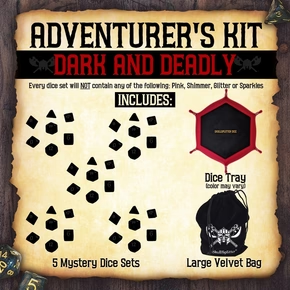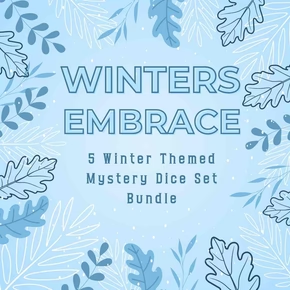
5e Backgrounds for Dungeons and Dragons
5e Backgrounds in Dungeons and Dragons: Everything You Need to Know
Backgrounds in 5th edition D&D are a small component of every character. They’re 90% flavor with a little smattering of mechanical features.If you're reading through the Player's Handbook you're probably wondering "How do they work?" Which background is right for you? Allow us to explain everything you need to know and dnd backgrounds.
Table of Contents:
What’s a Background For?
A character’s race explains what they ARE, a character’s class explains what they DO, a character’s background explains how they LIVED. Backgrounds also give your character proficiency in certain skills, as well as a few minor items to add flavor.
Fundamentally, your background is just a big ol’ dollop of flavor that you get to add to your character, not as much a focus on all of the skills. Each one gives a general description of your character’s life up to the point they started the adventuring lifestyle. You’re not just a fighter, you’re a fighter who lived their life sailing the high seas and plundering merchant vessels. You’re not just a wizard, you were an ascetic sage who has now returned to civilization to stave off the grave catastrophe you keep seeing in your dreams.
Mix and Match
One of the most interesting aspects dnd 5e backgrounds is just how loose the RAW rules are for them. You have a list of options yes, but take a look at this often missed or underused rule from the player’s handbook:
Creating Custom Backgrounds for 5E
You might want to customize your character with a unique background. Creating your own background is a simple process. You choose four skills and a trait from the sample backgrounds, and spend 175 gp on gear. (You can't also take the equipment package suggested for your class.) If you can't find a trait that matches your desired background, work with your DM to write one.
As a rule of thumb, a trait should tie your character to the world in some way. It should provide links to organizations and people that your character had contact with in the days before he or she became an adventurer. It can also reflect special advantages and opportunities that a member of that background enjoys. Traits never improve your character's class abilities or provide numerical bonuses on checks, saves, and so forth.
No other aspect of a 5e character has this much freedom and versatility. This is a RAW rule that just allows you to make your own option! You’re not compelled to, but in an edition where even feats are technically a house rule, it’s amazing that one of the main components of every character is so intrinsically versatile. If your character’s backstory just doesn’t fit any of the preset backgrounds, you have full reign to mix and match.
What Does my 5e Background Do?

Beyond the flavor of your backstory and history, each background provides a few mechanical advantages in a bunch of different combinations:
- 1-2 skill proficiencies.
- 1-2 languages.
- An assortment of starting gear.
- A unique ability, typically a situational social ability.
This isn’t all that much when it’s all said and done. But that’s it, your background is mostly here for flavor. In addition to the mechanics, each background provides you with tables filled with your “Personality Traits”, “Bonds”, “Ideals”, and “Flaws”.
I remember when I first shifted my games from pathfinder to 5e and I kept reading through them and couldn’t find what these traits actually did. The answer is nothing! You can completely ignore them if you feel like it, but what they do exceptionally well is help players who aren’t used to roleplaying. If you haven’t gotten farther than “Steve, the Human Fighter” as a character concept, backgrounds provide you with an instant injection of flavor and characterization.
What are my Options?
The players handbook provides us with backgrounds that cover pretty much everything in a somewhat generic way along with some subtle variants, then as 5e books have progressed we’ve gotten more specialized backgrounds unique to certain settings. We have 56 official backgrounds now, but let’s just discuss the ones you start with in the player’s handbook. Here’s their raw mechanics laid out as a table:
Background |
Skill Proficiencies |
Tool Proficiencies |
Extra Languages |
|
Acolyte |
Insight (WIS), Religion (INT) |
- |
Any 2 |
|
Charlatan |
Deception (CHA), Sleight of Hand (DEX) |
Disguise Kit, Forgery Kit |
- |
|
Criminal |
Deception (CHA), Stealth (DEX) |
Gaming set x1, Thieves' tools |
- |
|
Entertainer |
Acrobatics (DEX), Performance (CHA) |
Disguise kit, Musical instrument x1 |
- |
|
Folk Hero |
Animal handling (WIS), Survival (WIS) |
Artisan's tools x1, Vehicles (land) |
- |
|
Guild Artisan |
Insight (WIS), Persuasion (CHA) |
Artisan's tools x1 |
Any 1 |
|
Hermit |
Medicine (WIS), Religion (INT) |
Herbalism kit |
Any 1 |
|
Noble |
History (INT), Persuasion (CHA) |
Gaming set x1 |
Any 1 |
|
Outlander |
Athletics (STR), Survival (WIS) |
Musical instrument x1 |
Any 1 |
|
Sage |
Arcana (INT), History (INT) |
- |
Any 2 |
|
Sailor |
Athletics (STR), Perception (WIS) |
Navigator's tools, Vehicles (water) |
- |
|
Soldier |
Athletics (STR), Intimidation (CHA) |
Gaming set x1, Vehicles (land) |
- |
|
Urchin |
Sleight of Hand (DEX), Stealth (DEX) |
Disguise kit, Thieves' tools |
- |
Beyond the simple proficiencies, each background has one or more “features” and an assortment of gear. The gear you get rarely matters beyond 1st level, but the features can have a real impact.
Acolyte
Feature: Shelter of the Faithful
This feature simply allows you to get some extra considerations at temples and shrines to your deity and occasionally get the priests on your side. It’s situational at best, but there are some scenarios where getting sanctuary in the local church can come in handy.
Charlatan
Feature: False Identity
This feature is basically a free license to accurately forge documents. If you can’t think of some nefarious applications of this, you’re not thinking hard enough.
Criminal
Feature: Criminal Contact
This feature lets you get the lay of the land in any criminal underworld. I think of all the background features, this is the one I see get the most actual use. If your campaign takes place primarily in a city or cities, this is the one to have.
Entertainer
Feature: By Popular Demand
This feature is like the acolyte feature in that you can usually leverage it into free room and board. You can also get somewhat popular and liked in places you perform. Usually a feature for bards, it’s situational at best, but very flavorful.
Folk Hero
Feature: Rustic Hospitality
This is very similar to both the acolyte and entertainer features but is probably the most useful because it stipulates that people will be willing to hide you from the law. I’ve had more than one adventure saved by this feature as we hide from the cops in a friendly farmhouse.
Guild Artisan
Feature: Guild Membership
Another in the vein of “Group X Likes You” features, it functions a lot like the folk hero feature with a bit more legal oomph. Your guild won’t hide you, but they might pay your bail or for a lawyer. This does come with a minor gold cost each month, but the payoff can be a lifesaver.
Hermit
Feature: Discovery
This feature is more for your DM than it is for you. The discovery feature is essentially an excuse to tie your character to the main plot thread. If you’re in a situation where it’s difficult to integrate your character into an existing campaign, use this feature as an easy in.
Noble
Feature: Position of Privilege
This feature essentially allows you to enjoy some privilege, get an in with nobility and it generally gives you an excuse to lord it over people. Use with caution, as your fellow players are unlikely to tolerate much snooty behavior.
Outlander
Feature: Wanderer
This feature lets you get a little taste of Ranger as any other class. It only comes up in the rare survival style adventures, but when it does come up, you’ll be glad you have it.
Sage
Feature: Researcher
This is the obligatory wizard feature. It’s another feature that comes up the most often, and you can generally use it to figure out plot-relevant information whenever you’re stuck.
Sailor
Feature: Ship's Passage
It’s very situational, and often ignored down the line, but in early levels getting a free naval passage can be helpful.
Soldier
Feature: Military Rank
A very situational feature that really depends on the adventure. You gain the rank and military knowhow to access military installations, sort of. Generally, you’ll be linked to a single military, meaning the feature does literal nothing beyond your nation’s borders.
Urchin
Feature: City Secrets
This is a fun one but again, it’s very situational. You get to move at “double speed” out of combat while in cities. It rarely comes up, but in city chase sequences this feature can help you to catch the escaping thieves, or similarly escape from the law.
What Should I Pick?
We’ve only covered the basic core backgrounds here, there are functionally infinite options given that you can mix and match the 60 or so official backgrounds, and hundreds of unofficial ones. I can’t really tell you what background you “should” pick, because so little of their use is mechanical anyway. Go, pick out whatever background feels like it best represents your character, and feel free to remix them if you can’t find one that feels exactly right.
5e Backgrounds FAQs (Frequently Asked Questions)

How do backgrounds work in 5e?
Your background is meant to represent your character’s life before they became an adventurer. All characters must select a background when the character is first created. Each background gives an assortment of skill and tool proficiencies, alongside some extra starting equipment at 1st level. They’ll also usually have 1 or 2 special features that grant your character some special roleplaying opportunities, like knowledge of the local black markets, or free passage on ships due to your previous life as a sailor. Most backgrounds will also provide tables for your bonds, flaws, and ideals, but these are optional suggestions and you aren’t required to use them.
How do I make a D&D Backstory?
Writing is hard, no doubts about it, so when confronted with the intimidating blank page of your character’s backstory it’s natural to have some trouble, but Don’t Panic! With a few steps you can turn that blank page into something deep and interesting without a lot of work.
1: Gauge Time
If you’re making a game for a 1-shot or something really short, you don’t really need much of a backstory simply because there isn’t much time for it to come up. For really short adventures, just a simple “he came from X country, he’s avenging his destroyed village” is usually enough.
2: Write 2-3 Core Events
Nothing’s worse than “I am a fighter, my backstory is a love of fighting”. People tend to be shaped by core memories, major events in their lives that made them who they are today. Even if your character is just a “fighter who loves fighting”, how did they get that way. Were they inspired by some great hero? Was their parent a master of a martial art? How did they get from where they were to where they are now? You don’t need to fill in all the blanks, the bad guy who burned your town can remain “some bad guy”, it’s better to be a bit vague and paint in broad strokes so you can work with your DM later to fill in those blanks. But for now, try to come up with 2-3 core events in your character’s life that define who they are.
3: Tie It All In
Now that you have your backstory’s events written up, now you should work with your DM to tie them into the adventure. Any places, people and things you left vague can now be combined with your DM’s planned story. Now that vague villain who burned your town down has a name and may well be a primary antagonist for your adventures. The places, people, and things from your backstory can be allowed to grow naturally into the plot as you progress through the campaign.
This is a simplistic model for writing your character’s backstory, but it’ll do the job. If you’re looking for some more in-depth advice and examples, Matt Mercer’s book Explorer’s Guide to Wildemount has an incredible section devoted to backstory creation that you can find here.
How do I make a D&D character?
This is a big question, but I find there are two general schools of thought on this: Mechanic-Centered Character Building, and Lore-Centered Character Building. Neither approach is better or worse, they just take differing priorities.
Mechanic-Centered Character Building
This approach starts with the mechanical aspects of your character, an example is if you're looking for the best dnd monk backgrounds, then figures out their personality and history later. If you have an idea for a fun combat strategy or aspect of the gameplay you’d like to focus on, 5e is a simple and flexible system and most strategies are possible in one way or another. Consider multi-classing to maximize your strategy or looking around online for interesting combinations and successful builds.
Once you have your mechanical choices made (background, class, race, ability scores, equipment, Etc.) you can finally figure out what makes your character tick. For characters that multi-class, the journey between those disciplines can be fascinating and ripe ground for an interesting character arc. How exactly did your paladin/warlock character get to where they are now? Were they fooled by some eldritch power and then found the light? Has your character’s relation to some otherworldly patron shifted from a pact towards a true oath of devotion? It’s okay to let your character’s mechanics inform their story, just spend some time exploring how they got from point A to point B.
Lore-Centered Character Building
This takes the exact opposite approach and starts with the personality and history of your character and figures out the mechanical aspects of your character later. Start with an idea for a character trope or a personality you want to roleplay with and then build from there. The daughter of a local noble rebelling and running away from home to find adventure. A member of a primal or bestial culture entering civilization and experiencing everything for the first time. A wizened mage tantalizingly close to achieving his arcane masterpiece and seeking out that one last missing ingredient.
Once you know what kind of character you want to play, you can figure out the mechanical options that best represent the character in your head. 5e is very flexible, and there’s very little that you can come up with that can’t be described by some combination of options. Simply select the options (background, class, race, ability scores, equipment, Etc.) that you think best suits your idea and unlike many other systems, it’s pretty hard to have a “non-functional” character. You have to try pretty hard (a dumb wizard, a barbarian with no Strength, Etc.) to make something that will “break”, and practically any combination will still yield a playable character for you to roleplay your heart out with.
Enjoy this Guide? You May Also Like:
Thinking about other classes? Check out our giant list of D&D 5e Tools and Tips here.
Hungry for Adventure? Your group will love these D&D Game Night Snack Recipes
Need New Dice? Check out our Dice here.
New to find a D&D Group? Check out our guide on How to Find a D&D Group.
New to D&D? Check out our Beginner's Guide to D&D
Want to learn more about the gods in D&D? Check out our Deities 5e Guide
Feel like taking a huge chance and drawing from a deck that could ruin the whole campaign? Check out the infamous magic item: Deck of Many Things in 5e
Check out the reptilian like race in our Lizard Folk 5e guide
Looking for a Group? Check out our “How to Find a Dungeons and Dragons Tabletop Group” Guide
Our Complete Magic Item 5e Guide HERE.
Want to play a proud horse person? Check out our Centaur 5e Guide.

Disclaimer
Last updated: January 27, 2019
The information contained on www.SkullSplitterDice.com website (the "Service") is for general information purposes only.
www.SkullSplitterDice.com is a participant in the Amazon Services LLC Associates Program, an affiliate advertising program designed to provide a means for sites to earn advertising fees by advertising and linking to Amazon.com. (source: Section 5)
Blueshift Nine, LLC assumes no responsibility for errors or omissions in the contents on the Service.
In no event shall Blueshift Nine, LLC be liable for any special, direct, indirect, consequential, or incidental damages or any damages whatsoever, whether in an action of contract, negligence or other tort, arising out of or in connection with the use of the Service or the contents of the Service. Blueshift Nine, LLC reserves the right to make additions, deletions, or modification to the contents on the Service at any time without prior notice.
Blueshift Nine, LLC does not warrant that the Service is free of viruses or other harmful components.
Affiliate disclaimer
This affiliate disclosure details the affiliate relationships of Blueshift Nine, LLC with other companies and products.
Some of the links are "affiliate links", a link with a special tracking code. This means if you click on an affiliate link and purchase the item, we will receive an affiliate commission.
The price of the item is the same whether it is an affiliate link or not. Regardless, we only recommend products or services we believe will add value to our readers.
By using the affiliate links, you are helping support the Service, and we genuinely appreciate your support.
Affiliate advertising programs that the Service uses are:
- Amazon Services LLC Associates Program
- As an Amazon Associate, I earn from qualifying purchases.
- Blueshift Nine, LLC is a participant in the Amazon Services LLC Associates Program, an affiliate advertising program designed to provide a means for sites to earn advertising fees by advertising and linking to Amazon.com or endless.com, MYHABIT.com, SmallParts.com, or AmazonWireless.com.
- Pages on this Service may include affiliate links to Amazon and its affiliate sites on which the owner of this Service, Blueshift Nine, LLC, will make a referral commission.


